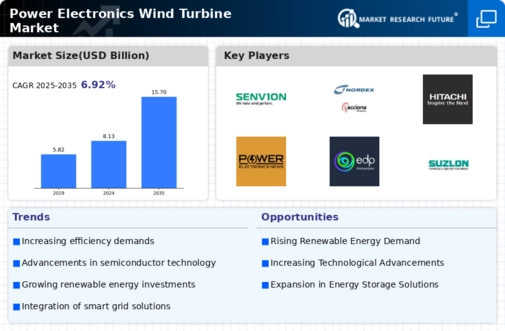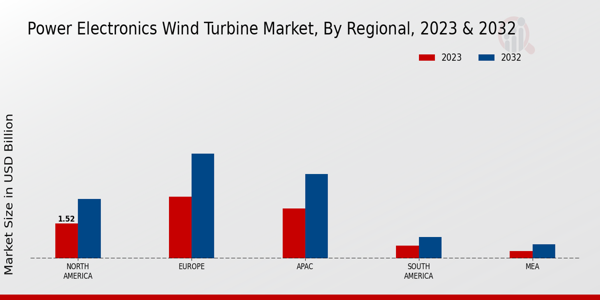Market Growth Projections
The Global Power Electronics Wind Turbine Market Industry is poised for substantial growth, with projections indicating a market value of 8.13 USD Billion in 2024, escalating to 15.7 USD Billion by 2035. This growth trajectory suggests a compound annual growth rate (CAGR) of 6.17% from 2025 to 2035. Such figures underscore the increasing adoption of wind energy solutions and the critical role of power electronics in enhancing the efficiency and reliability of wind turbines. The market dynamics reflect a broader trend towards sustainable energy, driven by technological advancements and supportive government policies.
Government Incentives and Subsidies
Government incentives and subsidies play a crucial role in fostering the Global Power Electronics Wind Turbine Market Industry. Many countries provide financial support for renewable energy projects, including tax credits, grants, and feed-in tariffs. For instance, the United States offers the Production Tax Credit, which has significantly boosted wind energy investments. Such financial mechanisms lower the barriers to entry for new projects and encourage the adoption of wind technology. As a result, the market is poised for substantial growth, with projections indicating a rise from 8.13 USD Billion in 2024 to 15.7 USD Billion by 2035.
Growing Demand for Renewable Energy
The increasing global emphasis on renewable energy sources drives the Global Power Electronics Wind Turbine Market Industry. Governments worldwide are implementing policies to reduce carbon emissions and promote sustainable energy solutions. For instance, the European Union aims to achieve a 55 percent reduction in greenhouse gas emissions by 2030, which necessitates a significant expansion of wind energy capacity. This shift is reflected in the projected market value, which is expected to reach 8.13 USD Billion in 2024 and grow to 15.7 USD Billion by 2035, indicating a robust demand for power electronics in wind turbines.
Increased Investment in Infrastructure
The surge in investment in renewable energy infrastructure is a driving force behind the Global Power Electronics Wind Turbine Market Industry. Countries are increasingly allocating funds to develop wind farms and associated technologies, recognizing the long-term benefits of sustainable energy. For example, China has invested heavily in offshore wind projects, aiming to become a global leader in wind energy production. This influx of capital not only enhances the deployment of wind turbines but also stimulates the demand for advanced power electronics. Consequently, the market is expected to experience a robust growth trajectory, with a projected CAGR of 6.17% from 2025 to 2035.
Rising Awareness of Environmental Issues
The growing public awareness of environmental issues is significantly influencing the Global Power Electronics Wind Turbine Market Industry. As climate change becomes a pressing global concern, consumers and businesses alike are advocating for cleaner energy solutions. This shift in perception is prompting governments and corporations to invest in renewable energy sources, particularly wind power. The increasing preference for sustainable energy options is likely to drive demand for power electronics in wind turbines, facilitating their integration into the energy grid. This trend is expected to contribute to the market's growth, with a projected increase from 8.13 USD Billion in 2024 to 15.7 USD Billion by 2035.
Technological Advancements in Power Electronics
Technological innovations in power electronics are pivotal to enhancing the efficiency and reliability of wind turbines, thereby propelling the Global Power Electronics Wind Turbine Market Industry. Developments such as advanced converters and control systems improve energy conversion and grid integration. For example, the introduction of multi-level converters has shown to enhance performance in variable-speed wind turbines. These advancements not only optimize energy output but also reduce operational costs, making wind energy more competitive. As a result, the market is projected to grow at a CAGR of 6.17% from 2025 to 2035, reflecting the impact of these technological improvements.





















Leave a Comment